CAN THE ARCHIPELAGO ENTER THE MUSEUM? IBEROAMERICA IN THE PROPOSAL OF THE HELGA DE ALVEAR MUSEUM
“I imagine the museum as an archipelago. It is not a continent, but an archipelago (...) The idea today is to put the world in contact with the world, to put some parts of the world in contact with other parts of the world... We must multiply the number of worlds inside museums”. Édouard Glissant (Sainte-Marie, Martinique, 1929-Paris, France, 2011) expressed his vision of museum functionality in this metaphorical way in his work Poetics of Relationship (1990).
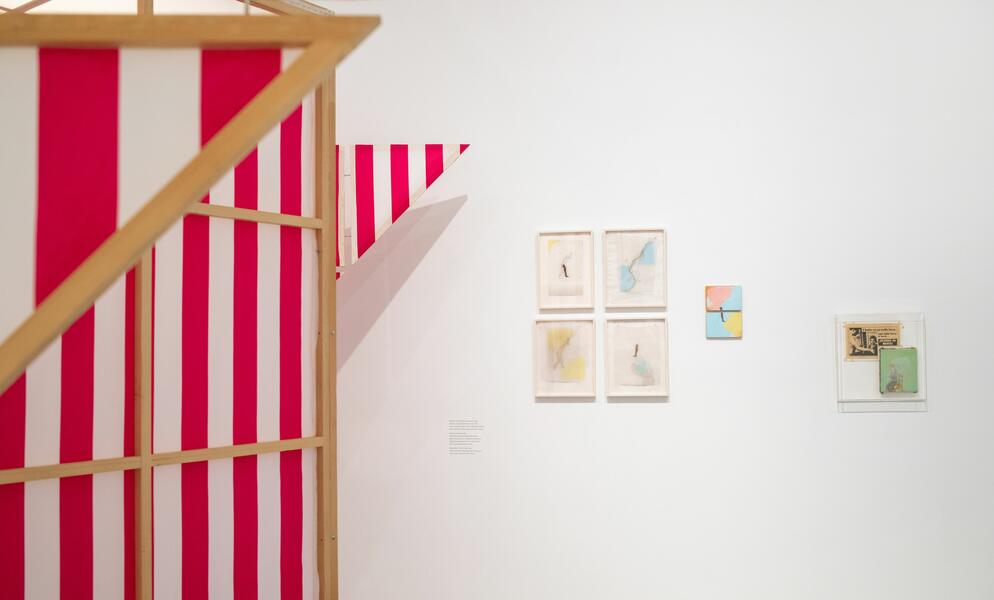
Based on this statement, the Helga de Alvear Museum in Cáceres, Spain, asks in its exhibition Can the Archipelago enter the Museum? #1 if its premises were feasible and had the capacity to materialize in that network of islands that make up the works and artists that use the exhibition space to interrelate and exchange the necessary positions to understand a whole without losing the individual essence.
It can be said that this group show is the presentation of a museological project in several stages, all on the same common thread, which are being shaped on the funds of the Helga de Alvear Collection and where it has been intended to isolate the vocation of the single story in favor of an exhibition where the richness and personality and different contexts of each work throws more questions than answers and facilitates, in a way, to understand Glissant's critical starting point.
Can the Archipelago enter the Museum? #1 makes use of the production of artists with different trajectories and technical preferences, among which are several reference names in contemporary Ibero-American art that, with their contribution, weave those parts and relational lines between agents to make sense of the curatorial experiment.
Among the relations with the production of Thomas Hirschhorn, Dominique Gonzalez-Foerster, Daniel Buren, Haegue Yang, Etel Adnan, Walid Raad, Rosemarie Trockel and Luc Tuymans, among others, we find the islets of Francis Alÿs (Antwerp, Belgium, 1959), Lygia Clark (Belo Horizonte, Brazil, 1920 - Rio de Janeiro, Brazil, 1988), Cristina Lucas (Jaén, Spain, 1973) or Carlos Bunga (Oporto Portugal, 1976), Ana Mendieta (Havana, Cuba, 1948 - New York, U.S.A., 1988), Ana Mendieta (Havana, Cuba, 1948 - New York, U.S.A., 1988) and Carlos Bunga (Oporto Portugal, 1976), among others. USA, 1985), Aurèlia Muñoz (Barcelona, Spain, 1926 - ibidem 2011) or Lygia Pepe (Nova Friburgo, Brazil, 1927 - Rio de Janeiro, Brazil, 2004).
To bring together the trajectory of these names in a strict sense, despite the little or much representation they may have in the exhibition, seems complicated given the idiosyncrasy of each element of this archipelago. Moreover, the selection of the elements seems to be sifted by that idea, expanding technical islands around each island, capturing the apparently contrasting paper and video works of Alÿs, the different sculptural techniques of Bunga or the collage and structures of Clarke.
Precisely for this reason, the presence of elements with a certain discontinuous character becomes important in the construction of that whole that starts from each contribution, from each temporal or structural reflection that provides the necessary material to, at least, question whether the principle formulated by Glissant is, at least, feasible.
Can the Archipelago enter the Museum? #1 until spring 2025 at the Helga de Alvear Museum, Calle Pizarro, 10, Cáceres (Spain).
May interest you
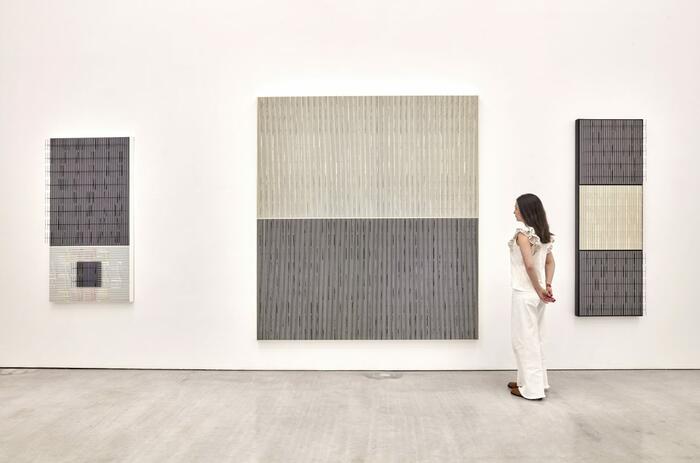
Jesús Rafael Soto (Ciudad Bolívar, Venezuela, 1923-Paris, France, 2005) carried out several investigations during the 1960s on possible solutions to face the fragmentation that his language needed. From those explorations emerged the T, a fine, metallic element of simple purity that allowed him to access, with satisfaction, to that disintegration he pursued and to reach a certain sensation of vibration and sublime volatility thanks to the linear disposition of these elements and their uniform arrangement that ended up giving the work a certain mediation between the spectator and the space and movement.

Jesús Rafael Soto (Ciudad Bolívar, Venezuela, 1923-Paris, France, 2005) carried out several investigations during the 1960s on possible solutions to face the fragmentation that his language needed. From those explorations emerged the T, a fine, metallic element of simple purity that allowed him to access, with satisfaction, to that disintegration he pursued and to reach a certain sensation of vibration and sublime volatility thanks to the linear disposition of these elements and their uniform arrangement that ended up giving the work a certain mediation between the spectator and the space and movement.
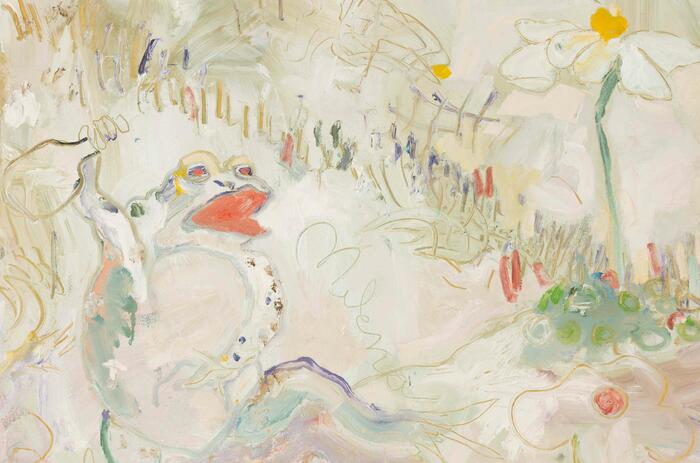
Travesía Cuatro hosts at its Madrid headquarters Surf and Turf, the fifth exhibition that the gallery dedicates to Milena Múzquiz (Tijuana, Mexico, 1972), that gathers, with about thirty works, the continuity of the production that began after the aesthetic and technical change produced by the end of Los Súper Elegantes, a musical group that he shared with the Argentine Martiniano López Crozet, and which represented a platform that brought together his purest expression through voice and body, as well as with the aesthetic possibilities of costumes and image.
THE DAILY LIFE AND POPULAR EXPRESSION OF MILENA MÚZQUIZ IN TRAVESÍA CUATRO
Travesía Cuatro hosts at its Madrid headquarters Surf and Turf, the fifth exhibition that the gallery dedicates to Milena Múzquiz (Tijuana, Mexico, 1972), that gathers, with about thirty works, the continuity of the production that began after the aesthetic and technical change produced by the end of Los Súper Elegantes, a musical group that he shared with the Argentine Martiniano López Crozet, and which represented a platform that brought together his purest expression through voice and body, as well as with the aesthetic possibilities of costumes and image.
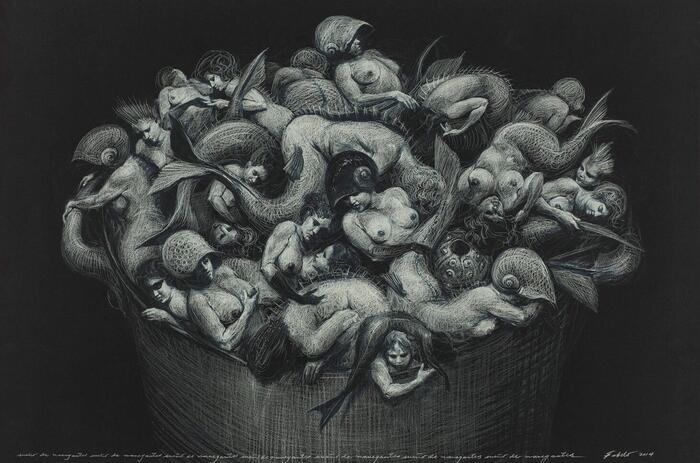
The DA2 hosts the last stage of the itinerancy of the Luciano Méndez Sánchez Contemporary Cuban Art Collection, a cycle of exhibitions that the collection started in 2019 in Spain in this institution and that reflects, through different curatorial lines, the realities and attitudes around contemporary art in Cuba.
THE LATEST TOUR AT DA2 OF THE LUCIANO MÉNDEZ SÁNCHEZ CONTEMPORARY CUBAN ART COLLECTION
The DA2 hosts the last stage of the itinerancy of the Luciano Méndez Sánchez Contemporary Cuban Art Collection, a cycle of exhibitions that the collection started in 2019 in Spain in this institution and that reflects, through different curatorial lines, the realities and attitudes around contemporary art in Cuba.
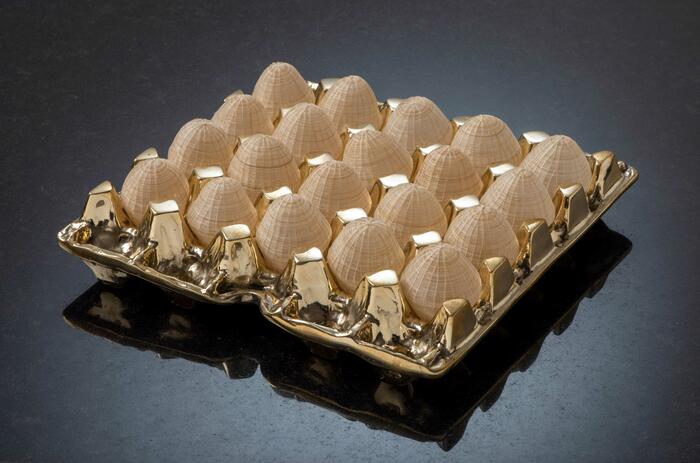
Rutas relacionales (Relational Routes) is the long-term collective with which the Lucía Mendoza gallery celebrates its tenth anniversary and with which it intends to raise awareness, through the work of about 40 artists, about several of the current thematic and philosophical axes, those that trace their need from the relationship of mankind with its environment. In these axes, we find lines of argument that deal with ecology, society and economies, passing through everything that composes them, such as political processes or the construction of identity.
"RELATIONAL ROUTES": THE LATIN AMERICAN COLLECTIVE EXHIBITION AT LUCÍA MENDOZA
Rutas relacionales (Relational Routes) is the long-term collective with which the Lucía Mendoza gallery celebrates its tenth anniversary and with which it intends to raise awareness, through the work of about 40 artists, about several of the current thematic and philosophical axes, those that trace their need from the relationship of mankind with its environment. In these axes, we find lines of argument that deal with ecology, society and economies, passing through everything that composes them, such as political processes or the construction of identity.
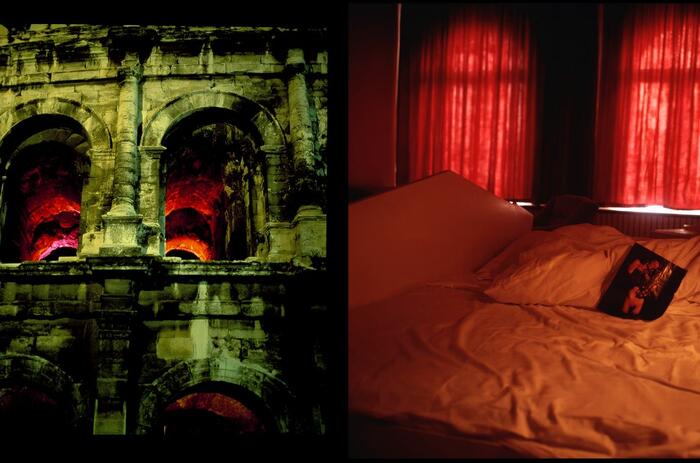
The Niemeyer Center, in the Asturian city of Aviles, hosts Tokyo Blues hacia Gritos Sordos (From Tokyo Blues to Deaf Cries), an exhibition by Brazilian photographer Miguel Rio Branco (Las Palmas de Gran Canaria, Spain, 1946) that traces a journey through his work of crossed images and pieces that were conceived from his personal experience on a trip to Japan, a country whose culture and names in cinema, art and architecture have always fascinated the artist.
RIO BRANCO'S JAPANESE FASCINATION IN AVILÉS
The Niemeyer Center, in the Asturian city of Aviles, hosts Tokyo Blues hacia Gritos Sordos (From Tokyo Blues to Deaf Cries), an exhibition by Brazilian photographer Miguel Rio Branco (Las Palmas de Gran Canaria, Spain, 1946) that traces a journey through his work of crossed images and pieces that were conceived from his personal experience on a trip to Japan, a country whose culture and names in cinema, art and architecture have always fascinated the artist.
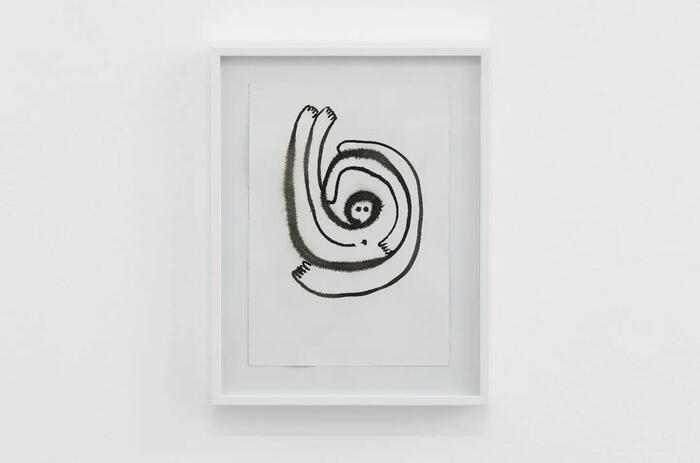
The Kunsthalle Lissabon presents Quinze Anos de Amor na República dos Pangolins (Fifteen Years of Love at the Pangolin Republic), the third and last exhibition with which the institution celebrates its fifteenth anniversary. On this occasion, the center has invited curator Filipa Ramos, one of the Portuguese professionals with the most international projection, who has managed to put together a roster of artists with a strong Latin American presence, with Ad Minoliti, Amalia Pica, Daniel Gustav Cramer, Flora Rebollo, Gabriel Chaile, Haris Epaminonda, Irene Kopelman, Jonathas de Andrade, Luís Lázaro Matos, Mariana Caló and Francisco Queimadela, Mounira Al Solh, Nuno Sousa Vieira, Sheroanawe Hakihiiwe, Sol Calero, Teresa Solar Abboud and Wilfredo Prieto.
LATIN AMERICA AT THE XV ANNIVERSARY OF KUNSTHALLE LISSABON
The Kunsthalle Lissabon presents Quinze Anos de Amor na República dos Pangolins (Fifteen Years of Love at the Pangolin Republic), the third and last exhibition with which the institution celebrates its fifteenth anniversary. On this occasion, the center has invited curator Filipa Ramos, one of the Portuguese professionals with the most international projection, who has managed to put together a roster of artists with a strong Latin American presence, with Ad Minoliti, Amalia Pica, Daniel Gustav Cramer, Flora Rebollo, Gabriel Chaile, Haris Epaminonda, Irene Kopelman, Jonathas de Andrade, Luís Lázaro Matos, Mariana Caló and Francisco Queimadela, Mounira Al Solh, Nuno Sousa Vieira, Sheroanawe Hakihiiwe, Sol Calero, Teresa Solar Abboud and Wilfredo Prieto.
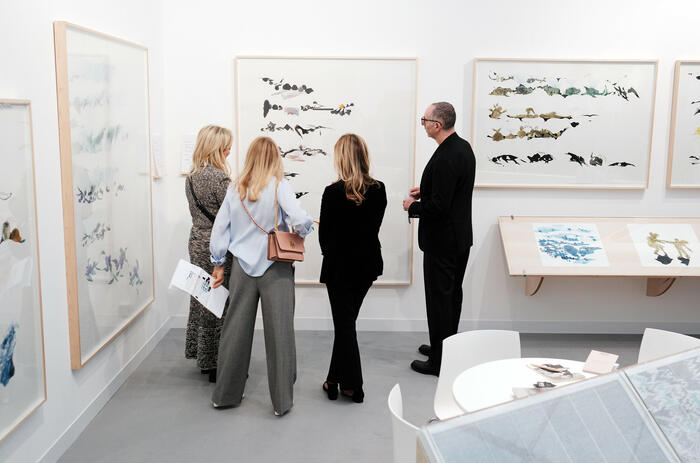
Mid-October marks a pivotal moment in the art world, as the spotlight shifts between London and Paris. First up is London, with Frieze opening on October 9th accompanied by a flurry of gallery openings and art events across the city. This season also sees important auctions, with leading houses hosting sales of Modern and Contemporary art.
A TALE OF TWO CITIES: LONDON VS. PARIS, THE ART WORLD’S ONGOING RIVALRY
Mid-October marks a pivotal moment in the art world, as the spotlight shifts between London and Paris. First up is London, with Frieze opening on October 9th accompanied by a flurry of gallery openings and art events across the city. This season also sees important auctions, with leading houses hosting sales of Modern and Contemporary art.
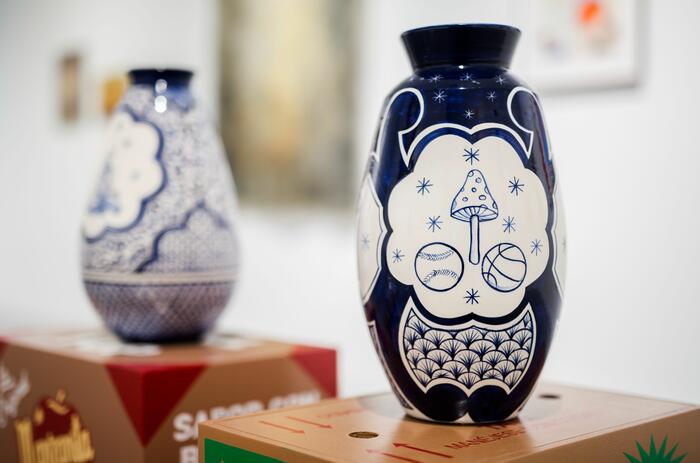
In an art industry that increasingly advocates following the lines established by cultural policies, it is always comforting to return to thesis themes, to environments that draw from social and historiographic sources, of course, but also from myths and a well-understood anthropology. You can go deeper in subtitles and lines or you can put together a skeleton, but the overview can also be a reward these days.
THE FIRE KEEPERS, A PERSPECTIVE ON THE MYTH OF FIRE FROM A MEXICAN CURATORIAL PERSPECTIVE
In an art industry that increasingly advocates following the lines established by cultural policies, it is always comforting to return to thesis themes, to environments that draw from social and historiographic sources, of course, but also from myths and a well-understood anthropology. You can go deeper in subtitles and lines or you can put together a skeleton, but the overview can also be a reward these days.
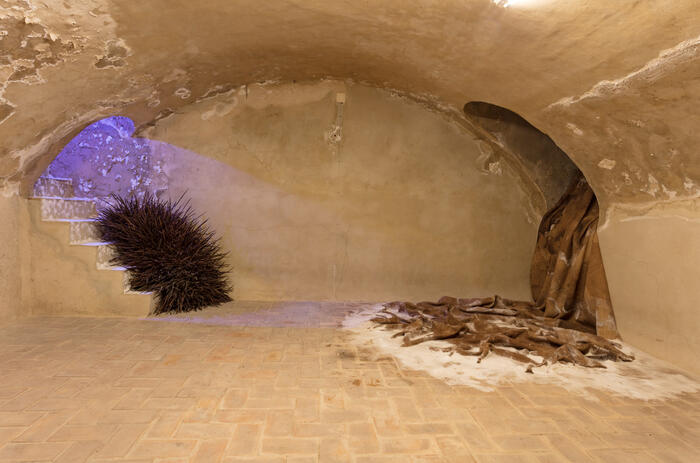
The Andalusian Center for Contemporary Art (CAAC) is showing Continuum or the appearance of the parts and the whole in its recovered space in the cellars of the institution's complex in Seville, an exhibition whose origin is to be sought in Profundis, the proposal that Colombian Delcy Morelos (Tierralta, Colombia, 1967) made for this same center this year and that served as a framework to sublimate, from the analysis, the dialogue beyond the material and the relationship she kept with her collaborators when it came to putting together her recent exhibition.
CONTINUUM: FROM THE DIALOGUE WITH DELCY MORELOS
The Andalusian Center for Contemporary Art (CAAC) is showing Continuum or the appearance of the parts and the whole in its recovered space in the cellars of the institution's complex in Seville, an exhibition whose origin is to be sought in Profundis, the proposal that Colombian Delcy Morelos (Tierralta, Colombia, 1967) made for this same center this year and that served as a framework to sublimate, from the analysis, the dialogue beyond the material and the relationship she kept with her collaborators when it came to putting together her recent exhibition.
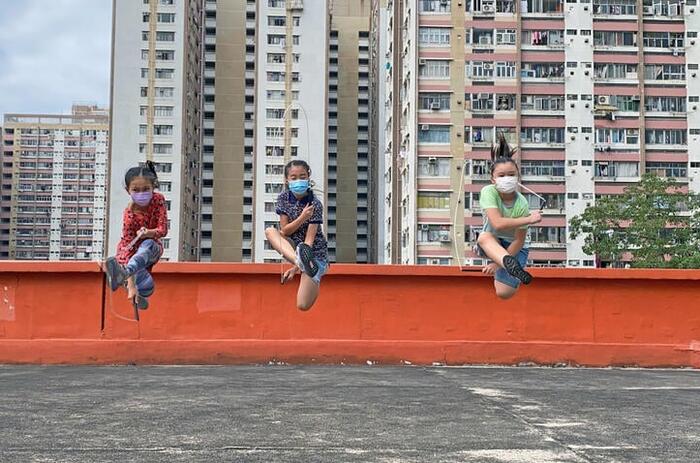
Francis Alÿs (Antwerp, Belgium, 1959) began, at the end of the last century, to abandon the exclusivity of his body as the subject of the actions of his artistic proposal to begin to explore the possibility of finding and employing other subjects for this purpose. With this idea, the figure of children gained more and more importance in his production and became the sign of identity of a new stage for the new millennium.
ALŸS AND THE COLLABORATIVE PHILOSOPHY OF THE GAME AT SERRALVES
Francis Alÿs (Antwerp, Belgium, 1959) began, at the end of the last century, to abandon the exclusivity of his body as the subject of the actions of his artistic proposal to begin to explore the possibility of finding and employing other subjects for this purpose. With this idea, the figure of children gained more and more importance in his production and became the sign of identity of a new stage for the new millennium.
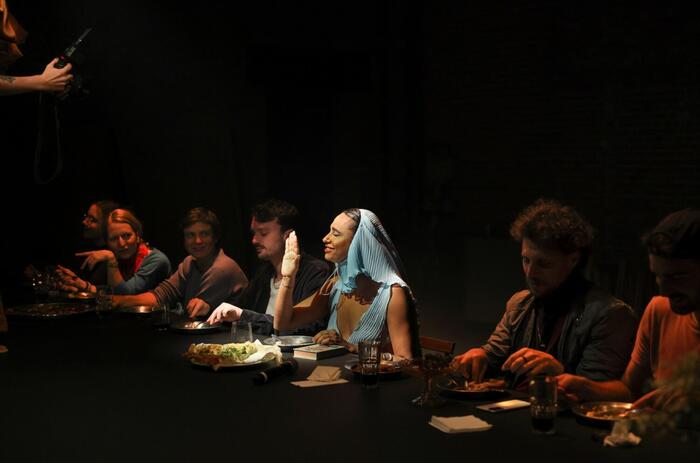
The Museum of Modern Art of São Paulo presents the 38th Panorama of Brazilian Art: Mil Graus [A thousand degrees], an exhibition curated by Germano Dushá and Thiago de Paula Souza, and co-curated by Ariana Nuala, whose title evokes the idea of a “heat-limit,” where everything is transformed, referring to the intense climatic and metaphysical conditions that challenge and lead to inevitable processes of transmutation. In this edition, the MAM biennial exhibition presents 34 artists from 16 Brazilian states.
THE 38TH BRAZILIAN ART PANORAMA: ECOLOGY AND FUTURE
The Museum of Modern Art of São Paulo presents the 38th Panorama of Brazilian Art: Mil Graus [A thousand degrees], an exhibition curated by Germano Dushá and Thiago de Paula Souza, and co-curated by Ariana Nuala, whose title evokes the idea of a “heat-limit,” where everything is transformed, referring to the intense climatic and metaphysical conditions that challenge and lead to inevitable processes of transmutation. In this edition, the MAM biennial exhibition presents 34 artists from 16 Brazilian states.
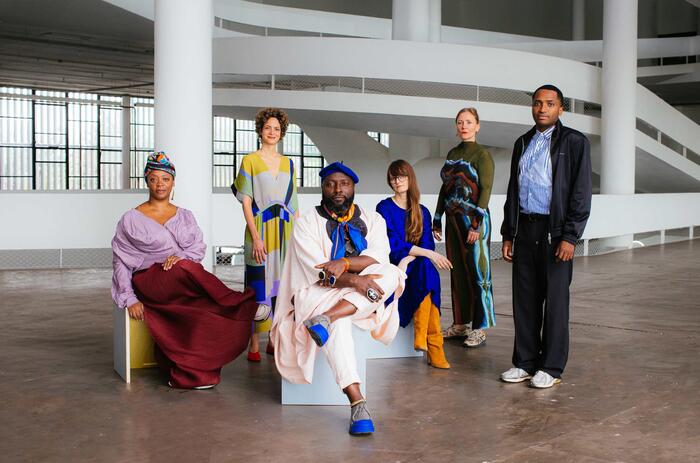
Under the general curatorship of Bonaventure by Soh Bejen Ndikung, the 36th São Paulo Biennial announces its title, curatorial concept, collaborators and visual identity, in addition to informing about an important change in its exhibition period. The title will be: Nem todo viandante anda estradas / Da humanidade como prática [Not All Travelers Walk Roads / Of Humanity as Practice].
THEME AND CURATORIAL CONCEPT FOR THE 36TH SÃO PAULO BIENNIAL ANNOUNCED
Under the general curatorship of Bonaventure by Soh Bejen Ndikung, the 36th São Paulo Biennial announces its title, curatorial concept, collaborators and visual identity, in addition to informing about an important change in its exhibition period. The title will be: Nem todo viandante anda estradas / Da humanidade como prática [Not All Travelers Walk Roads / Of Humanity as Practice].
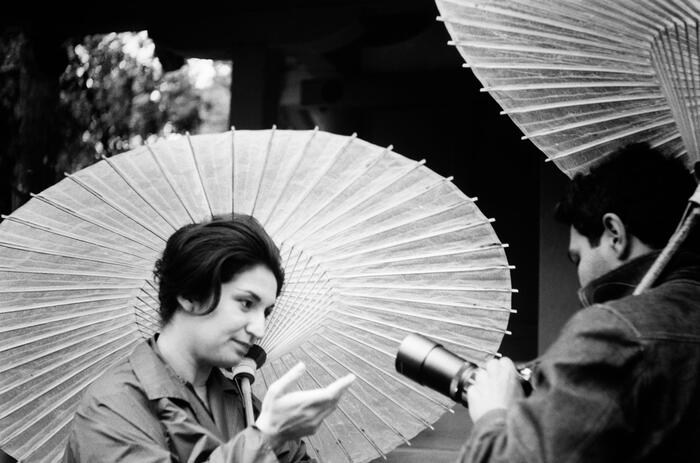
The approach and review of the work that the multidisciplinary Portuguese-Brazilian artist Fernando Lemos (Lisbon, Portugal, 1926 - São Paulo, Brazil, 2019) made in the framework of his relationship with Japan is the reason for the exhibitions that two centers of the Calouste Gulbenkian Foundation dedicate to his figure. It is worth remembering here that both of them transit in the Japanese concept that stands as the central axis of the new headquarters of the Centro de Arte Moderno, recently inaugurated, and on which the dialogue between both curatorial proposals pivots.
FERNANDO LEMOS AND JAPAN REVIEWED AT GULBENKIAN
The approach and review of the work that the multidisciplinary Portuguese-Brazilian artist Fernando Lemos (Lisbon, Portugal, 1926 - São Paulo, Brazil, 2019) made in the framework of his relationship with Japan is the reason for the exhibitions that two centers of the Calouste Gulbenkian Foundation dedicate to his figure. It is worth remembering here that both of them transit in the Japanese concept that stands as the central axis of the new headquarters of the Centro de Arte Moderno, recently inaugurated, and on which the dialogue between both curatorial proposals pivots.
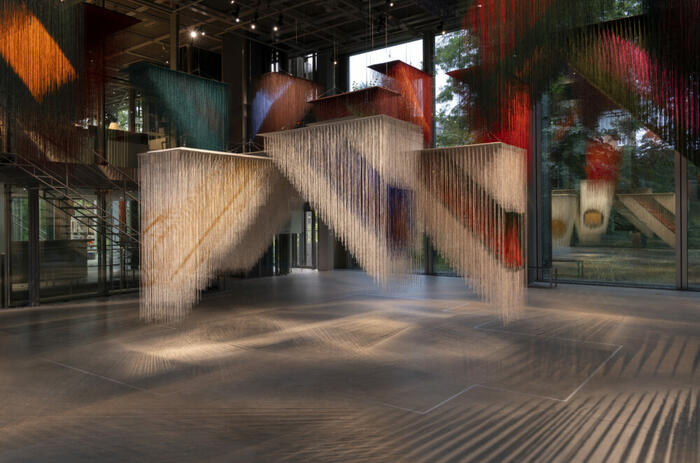
The Fondation Cartier pour l’art contemporain is presenting the first major retrospective in Europe of Olga de Amaral, a key figure of the Colombian art scene and of Fiber Art. The exhibition brings together nearly eighty works made between the 1960s and now, many of which have never been shown before outside of Colombia.
OLGA DE AMARAL IN PARIS: AN EXHIBITION AT THE FONDATION CARTIER
The Fondation Cartier pour l’art contemporain is presenting the first major retrospective in Europe of Olga de Amaral, a key figure of the Colombian art scene and of Fiber Art. The exhibition brings together nearly eighty works made between the 1960s and now, many of which have never been shown before outside of Colombia.
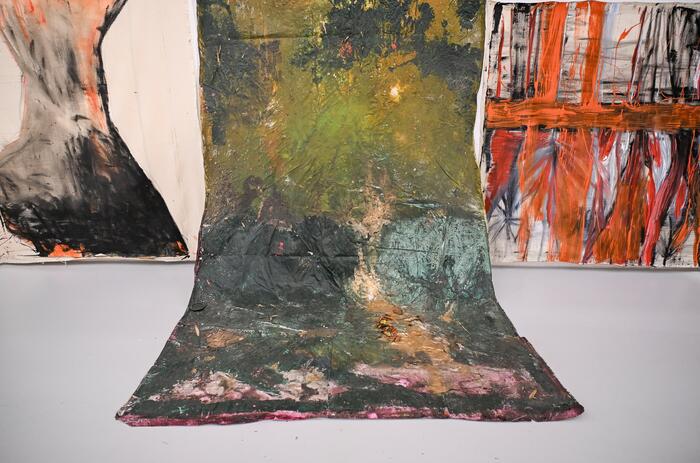
Lisbon's MAAT hosts the exhibition Disco, a show with more than half a thousand works by Vivian Suter (Buenos Aires, Argentina, 1949) with which the institution pays tribute to the pictorial production of the Swiss-Argentine artist and her particular exploration of the interaction with nature and the different techniques and possibilities applicable to painting.
VIVIAN SUTER AND THE RELEVANCE OF SURROUNDINGS AT MAAT IN LISBON
Lisbon's MAAT hosts the exhibition Disco, a show with more than half a thousand works by Vivian Suter (Buenos Aires, Argentina, 1949) with which the institution pays tribute to the pictorial production of the Swiss-Argentine artist and her particular exploration of the interaction with nature and the different techniques and possibilities applicable to painting.

Jesús Rafael Soto (Ciudad Bolívar, Venezuela, 1923-Paris, France, 2005) carried out several investigations during the 1960s on possible solutions to face the fragmentation that his language needed. From those explorations emerged the T, a fine, metallic element of simple purity that allowed him to access, with satisfaction, to that disintegration he pursued and to reach a certain sensation of vibration and sublime volatility thanks to the linear disposition of these elements and their uniform arrangement that ended up giving the work a certain mediation between the spectator and the space and movement.

Travesía Cuatro hosts at its Madrid headquarters Surf and Turf, the fifth exhibition that the gallery dedicates to Milena Múzquiz (Tijuana, Mexico, 1972), that gathers, with about thirty works, the continuity of the production that began after the aesthetic and technical change produced by the end of Los Súper Elegantes, a musical group that he shared with the Argentine Martiniano López Crozet, and which represented a platform that brought together his purest expression through voice and body, as well as with the aesthetic possibilities of costumes and image.
THE DAILY LIFE AND POPULAR EXPRESSION OF MILENA MÚZQUIZ IN TRAVESÍA CUATRO
Travesía Cuatro hosts at its Madrid headquarters Surf and Turf, the fifth exhibition that the gallery dedicates to Milena Múzquiz (Tijuana, Mexico, 1972), that gathers, with about thirty works, the continuity of the production that began after the aesthetic and technical change produced by the end of Los Súper Elegantes, a musical group that he shared with the Argentine Martiniano López Crozet, and which represented a platform that brought together his purest expression through voice and body, as well as with the aesthetic possibilities of costumes and image.

The DA2 hosts the last stage of the itinerancy of the Luciano Méndez Sánchez Contemporary Cuban Art Collection, a cycle of exhibitions that the collection started in 2019 in Spain in this institution and that reflects, through different curatorial lines, the realities and attitudes around contemporary art in Cuba.
THE LATEST TOUR AT DA2 OF THE LUCIANO MÉNDEZ SÁNCHEZ CONTEMPORARY CUBAN ART COLLECTION
The DA2 hosts the last stage of the itinerancy of the Luciano Méndez Sánchez Contemporary Cuban Art Collection, a cycle of exhibitions that the collection started in 2019 in Spain in this institution and that reflects, through different curatorial lines, the realities and attitudes around contemporary art in Cuba.

Rutas relacionales (Relational Routes) is the long-term collective with which the Lucía Mendoza gallery celebrates its tenth anniversary and with which it intends to raise awareness, through the work of about 40 artists, about several of the current thematic and philosophical axes, those that trace their need from the relationship of mankind with its environment. In these axes, we find lines of argument that deal with ecology, society and economies, passing through everything that composes them, such as political processes or the construction of identity.
"RELATIONAL ROUTES": THE LATIN AMERICAN COLLECTIVE EXHIBITION AT LUCÍA MENDOZA
Rutas relacionales (Relational Routes) is the long-term collective with which the Lucía Mendoza gallery celebrates its tenth anniversary and with which it intends to raise awareness, through the work of about 40 artists, about several of the current thematic and philosophical axes, those that trace their need from the relationship of mankind with its environment. In these axes, we find lines of argument that deal with ecology, society and economies, passing through everything that composes them, such as political processes or the construction of identity.

The Niemeyer Center, in the Asturian city of Aviles, hosts Tokyo Blues hacia Gritos Sordos (From Tokyo Blues to Deaf Cries), an exhibition by Brazilian photographer Miguel Rio Branco (Las Palmas de Gran Canaria, Spain, 1946) that traces a journey through his work of crossed images and pieces that were conceived from his personal experience on a trip to Japan, a country whose culture and names in cinema, art and architecture have always fascinated the artist.
RIO BRANCO'S JAPANESE FASCINATION IN AVILÉS
The Niemeyer Center, in the Asturian city of Aviles, hosts Tokyo Blues hacia Gritos Sordos (From Tokyo Blues to Deaf Cries), an exhibition by Brazilian photographer Miguel Rio Branco (Las Palmas de Gran Canaria, Spain, 1946) that traces a journey through his work of crossed images and pieces that were conceived from his personal experience on a trip to Japan, a country whose culture and names in cinema, art and architecture have always fascinated the artist.

The Kunsthalle Lissabon presents Quinze Anos de Amor na República dos Pangolins (Fifteen Years of Love at the Pangolin Republic), the third and last exhibition with which the institution celebrates its fifteenth anniversary. On this occasion, the center has invited curator Filipa Ramos, one of the Portuguese professionals with the most international projection, who has managed to put together a roster of artists with a strong Latin American presence, with Ad Minoliti, Amalia Pica, Daniel Gustav Cramer, Flora Rebollo, Gabriel Chaile, Haris Epaminonda, Irene Kopelman, Jonathas de Andrade, Luís Lázaro Matos, Mariana Caló and Francisco Queimadela, Mounira Al Solh, Nuno Sousa Vieira, Sheroanawe Hakihiiwe, Sol Calero, Teresa Solar Abboud and Wilfredo Prieto.
LATIN AMERICA AT THE XV ANNIVERSARY OF KUNSTHALLE LISSABON
The Kunsthalle Lissabon presents Quinze Anos de Amor na República dos Pangolins (Fifteen Years of Love at the Pangolin Republic), the third and last exhibition with which the institution celebrates its fifteenth anniversary. On this occasion, the center has invited curator Filipa Ramos, one of the Portuguese professionals with the most international projection, who has managed to put together a roster of artists with a strong Latin American presence, with Ad Minoliti, Amalia Pica, Daniel Gustav Cramer, Flora Rebollo, Gabriel Chaile, Haris Epaminonda, Irene Kopelman, Jonathas de Andrade, Luís Lázaro Matos, Mariana Caló and Francisco Queimadela, Mounira Al Solh, Nuno Sousa Vieira, Sheroanawe Hakihiiwe, Sol Calero, Teresa Solar Abboud and Wilfredo Prieto.

Mid-October marks a pivotal moment in the art world, as the spotlight shifts between London and Paris. First up is London, with Frieze opening on October 9th accompanied by a flurry of gallery openings and art events across the city. This season also sees important auctions, with leading houses hosting sales of Modern and Contemporary art.
A TALE OF TWO CITIES: LONDON VS. PARIS, THE ART WORLD’S ONGOING RIVALRY
Mid-October marks a pivotal moment in the art world, as the spotlight shifts between London and Paris. First up is London, with Frieze opening on October 9th accompanied by a flurry of gallery openings and art events across the city. This season also sees important auctions, with leading houses hosting sales of Modern and Contemporary art.

In an art industry that increasingly advocates following the lines established by cultural policies, it is always comforting to return to thesis themes, to environments that draw from social and historiographic sources, of course, but also from myths and a well-understood anthropology. You can go deeper in subtitles and lines or you can put together a skeleton, but the overview can also be a reward these days.
THE FIRE KEEPERS, A PERSPECTIVE ON THE MYTH OF FIRE FROM A MEXICAN CURATORIAL PERSPECTIVE
In an art industry that increasingly advocates following the lines established by cultural policies, it is always comforting to return to thesis themes, to environments that draw from social and historiographic sources, of course, but also from myths and a well-understood anthropology. You can go deeper in subtitles and lines or you can put together a skeleton, but the overview can also be a reward these days.

The Andalusian Center for Contemporary Art (CAAC) is showing Continuum or the appearance of the parts and the whole in its recovered space in the cellars of the institution's complex in Seville, an exhibition whose origin is to be sought in Profundis, the proposal that Colombian Delcy Morelos (Tierralta, Colombia, 1967) made for this same center this year and that served as a framework to sublimate, from the analysis, the dialogue beyond the material and the relationship she kept with her collaborators when it came to putting together her recent exhibition.
CONTINUUM: FROM THE DIALOGUE WITH DELCY MORELOS
The Andalusian Center for Contemporary Art (CAAC) is showing Continuum or the appearance of the parts and the whole in its recovered space in the cellars of the institution's complex in Seville, an exhibition whose origin is to be sought in Profundis, the proposal that Colombian Delcy Morelos (Tierralta, Colombia, 1967) made for this same center this year and that served as a framework to sublimate, from the analysis, the dialogue beyond the material and the relationship she kept with her collaborators when it came to putting together her recent exhibition.

Francis Alÿs (Antwerp, Belgium, 1959) began, at the end of the last century, to abandon the exclusivity of his body as the subject of the actions of his artistic proposal to begin to explore the possibility of finding and employing other subjects for this purpose. With this idea, the figure of children gained more and more importance in his production and became the sign of identity of a new stage for the new millennium.
ALŸS AND THE COLLABORATIVE PHILOSOPHY OF THE GAME AT SERRALVES
Francis Alÿs (Antwerp, Belgium, 1959) began, at the end of the last century, to abandon the exclusivity of his body as the subject of the actions of his artistic proposal to begin to explore the possibility of finding and employing other subjects for this purpose. With this idea, the figure of children gained more and more importance in his production and became the sign of identity of a new stage for the new millennium.

The Museum of Modern Art of São Paulo presents the 38th Panorama of Brazilian Art: Mil Graus [A thousand degrees], an exhibition curated by Germano Dushá and Thiago de Paula Souza, and co-curated by Ariana Nuala, whose title evokes the idea of a “heat-limit,” where everything is transformed, referring to the intense climatic and metaphysical conditions that challenge and lead to inevitable processes of transmutation. In this edition, the MAM biennial exhibition presents 34 artists from 16 Brazilian states.
THE 38TH BRAZILIAN ART PANORAMA: ECOLOGY AND FUTURE
The Museum of Modern Art of São Paulo presents the 38th Panorama of Brazilian Art: Mil Graus [A thousand degrees], an exhibition curated by Germano Dushá and Thiago de Paula Souza, and co-curated by Ariana Nuala, whose title evokes the idea of a “heat-limit,” where everything is transformed, referring to the intense climatic and metaphysical conditions that challenge and lead to inevitable processes of transmutation. In this edition, the MAM biennial exhibition presents 34 artists from 16 Brazilian states.

Under the general curatorship of Bonaventure by Soh Bejen Ndikung, the 36th São Paulo Biennial announces its title, curatorial concept, collaborators and visual identity, in addition to informing about an important change in its exhibition period. The title will be: Nem todo viandante anda estradas / Da humanidade como prática [Not All Travelers Walk Roads / Of Humanity as Practice].
THEME AND CURATORIAL CONCEPT FOR THE 36TH SÃO PAULO BIENNIAL ANNOUNCED
Under the general curatorship of Bonaventure by Soh Bejen Ndikung, the 36th São Paulo Biennial announces its title, curatorial concept, collaborators and visual identity, in addition to informing about an important change in its exhibition period. The title will be: Nem todo viandante anda estradas / Da humanidade como prática [Not All Travelers Walk Roads / Of Humanity as Practice].

The approach and review of the work that the multidisciplinary Portuguese-Brazilian artist Fernando Lemos (Lisbon, Portugal, 1926 - São Paulo, Brazil, 2019) made in the framework of his relationship with Japan is the reason for the exhibitions that two centers of the Calouste Gulbenkian Foundation dedicate to his figure. It is worth remembering here that both of them transit in the Japanese concept that stands as the central axis of the new headquarters of the Centro de Arte Moderno, recently inaugurated, and on which the dialogue between both curatorial proposals pivots.
FERNANDO LEMOS AND JAPAN REVIEWED AT GULBENKIAN
The approach and review of the work that the multidisciplinary Portuguese-Brazilian artist Fernando Lemos (Lisbon, Portugal, 1926 - São Paulo, Brazil, 2019) made in the framework of his relationship with Japan is the reason for the exhibitions that two centers of the Calouste Gulbenkian Foundation dedicate to his figure. It is worth remembering here that both of them transit in the Japanese concept that stands as the central axis of the new headquarters of the Centro de Arte Moderno, recently inaugurated, and on which the dialogue between both curatorial proposals pivots.

The Fondation Cartier pour l’art contemporain is presenting the first major retrospective in Europe of Olga de Amaral, a key figure of the Colombian art scene and of Fiber Art. The exhibition brings together nearly eighty works made between the 1960s and now, many of which have never been shown before outside of Colombia.
OLGA DE AMARAL IN PARIS: AN EXHIBITION AT THE FONDATION CARTIER
The Fondation Cartier pour l’art contemporain is presenting the first major retrospective in Europe of Olga de Amaral, a key figure of the Colombian art scene and of Fiber Art. The exhibition brings together nearly eighty works made between the 1960s and now, many of which have never been shown before outside of Colombia.

Lisbon's MAAT hosts the exhibition Disco, a show with more than half a thousand works by Vivian Suter (Buenos Aires, Argentina, 1949) with which the institution pays tribute to the pictorial production of the Swiss-Argentine artist and her particular exploration of the interaction with nature and the different techniques and possibilities applicable to painting.
VIVIAN SUTER AND THE RELEVANCE OF SURROUNDINGS AT MAAT IN LISBON
Lisbon's MAAT hosts the exhibition Disco, a show with more than half a thousand works by Vivian Suter (Buenos Aires, Argentina, 1949) with which the institution pays tribute to the pictorial production of the Swiss-Argentine artist and her particular exploration of the interaction with nature and the different techniques and possibilities applicable to painting.

Jesús Rafael Soto (Ciudad Bolívar, Venezuela, 1923-Paris, France, 2005) carried out several investigations during the 1960s on possible solutions to face the fragmentation that his language needed. From those explorations emerged the T, a fine, metallic element of simple purity that allowed him to access, with satisfaction, to that disintegration he pursued and to reach a certain sensation of vibration and sublime volatility thanks to the linear disposition of these elements and their uniform arrangement that ended up giving the work a certain mediation between the spectator and the space and movement.

Travesía Cuatro hosts at its Madrid headquarters Surf and Turf, the fifth exhibition that the gallery dedicates to Milena Múzquiz (Tijuana, Mexico, 1972), that gathers, with about thirty works, the continuity of the production that began after the aesthetic and technical change produced by the end of Los Súper Elegantes, a musical group that he shared with the Argentine Martiniano López Crozet, and which represented a platform that brought together his purest expression through voice and body, as well as with the aesthetic possibilities of costumes and image.
THE DAILY LIFE AND POPULAR EXPRESSION OF MILENA MÚZQUIZ IN TRAVESÍA CUATRO
Travesía Cuatro hosts at its Madrid headquarters Surf and Turf, the fifth exhibition that the gallery dedicates to Milena Múzquiz (Tijuana, Mexico, 1972), that gathers, with about thirty works, the continuity of the production that began after the aesthetic and technical change produced by the end of Los Súper Elegantes, a musical group that he shared with the Argentine Martiniano López Crozet, and which represented a platform that brought together his purest expression through voice and body, as well as with the aesthetic possibilities of costumes and image.

The DA2 hosts the last stage of the itinerancy of the Luciano Méndez Sánchez Contemporary Cuban Art Collection, a cycle of exhibitions that the collection started in 2019 in Spain in this institution and that reflects, through different curatorial lines, the realities and attitudes around contemporary art in Cuba.
THE LATEST TOUR AT DA2 OF THE LUCIANO MÉNDEZ SÁNCHEZ CONTEMPORARY CUBAN ART COLLECTION
The DA2 hosts the last stage of the itinerancy of the Luciano Méndez Sánchez Contemporary Cuban Art Collection, a cycle of exhibitions that the collection started in 2019 in Spain in this institution and that reflects, through different curatorial lines, the realities and attitudes around contemporary art in Cuba.

Rutas relacionales (Relational Routes) is the long-term collective with which the Lucía Mendoza gallery celebrates its tenth anniversary and with which it intends to raise awareness, through the work of about 40 artists, about several of the current thematic and philosophical axes, those that trace their need from the relationship of mankind with its environment. In these axes, we find lines of argument that deal with ecology, society and economies, passing through everything that composes them, such as political processes or the construction of identity.
"RELATIONAL ROUTES": THE LATIN AMERICAN COLLECTIVE EXHIBITION AT LUCÍA MENDOZA
Rutas relacionales (Relational Routes) is the long-term collective with which the Lucía Mendoza gallery celebrates its tenth anniversary and with which it intends to raise awareness, through the work of about 40 artists, about several of the current thematic and philosophical axes, those that trace their need from the relationship of mankind with its environment. In these axes, we find lines of argument that deal with ecology, society and economies, passing through everything that composes them, such as political processes or the construction of identity.

The Niemeyer Center, in the Asturian city of Aviles, hosts Tokyo Blues hacia Gritos Sordos (From Tokyo Blues to Deaf Cries), an exhibition by Brazilian photographer Miguel Rio Branco (Las Palmas de Gran Canaria, Spain, 1946) that traces a journey through his work of crossed images and pieces that were conceived from his personal experience on a trip to Japan, a country whose culture and names in cinema, art and architecture have always fascinated the artist.
RIO BRANCO'S JAPANESE FASCINATION IN AVILÉS
The Niemeyer Center, in the Asturian city of Aviles, hosts Tokyo Blues hacia Gritos Sordos (From Tokyo Blues to Deaf Cries), an exhibition by Brazilian photographer Miguel Rio Branco (Las Palmas de Gran Canaria, Spain, 1946) that traces a journey through his work of crossed images and pieces that were conceived from his personal experience on a trip to Japan, a country whose culture and names in cinema, art and architecture have always fascinated the artist.

The Kunsthalle Lissabon presents Quinze Anos de Amor na República dos Pangolins (Fifteen Years of Love at the Pangolin Republic), the third and last exhibition with which the institution celebrates its fifteenth anniversary. On this occasion, the center has invited curator Filipa Ramos, one of the Portuguese professionals with the most international projection, who has managed to put together a roster of artists with a strong Latin American presence, with Ad Minoliti, Amalia Pica, Daniel Gustav Cramer, Flora Rebollo, Gabriel Chaile, Haris Epaminonda, Irene Kopelman, Jonathas de Andrade, Luís Lázaro Matos, Mariana Caló and Francisco Queimadela, Mounira Al Solh, Nuno Sousa Vieira, Sheroanawe Hakihiiwe, Sol Calero, Teresa Solar Abboud and Wilfredo Prieto.
LATIN AMERICA AT THE XV ANNIVERSARY OF KUNSTHALLE LISSABON
The Kunsthalle Lissabon presents Quinze Anos de Amor na República dos Pangolins (Fifteen Years of Love at the Pangolin Republic), the third and last exhibition with which the institution celebrates its fifteenth anniversary. On this occasion, the center has invited curator Filipa Ramos, one of the Portuguese professionals with the most international projection, who has managed to put together a roster of artists with a strong Latin American presence, with Ad Minoliti, Amalia Pica, Daniel Gustav Cramer, Flora Rebollo, Gabriel Chaile, Haris Epaminonda, Irene Kopelman, Jonathas de Andrade, Luís Lázaro Matos, Mariana Caló and Francisco Queimadela, Mounira Al Solh, Nuno Sousa Vieira, Sheroanawe Hakihiiwe, Sol Calero, Teresa Solar Abboud and Wilfredo Prieto.

Mid-October marks a pivotal moment in the art world, as the spotlight shifts between London and Paris. First up is London, with Frieze opening on October 9th accompanied by a flurry of gallery openings and art events across the city. This season also sees important auctions, with leading houses hosting sales of Modern and Contemporary art.
A TALE OF TWO CITIES: LONDON VS. PARIS, THE ART WORLD’S ONGOING RIVALRY
Mid-October marks a pivotal moment in the art world, as the spotlight shifts between London and Paris. First up is London, with Frieze opening on October 9th accompanied by a flurry of gallery openings and art events across the city. This season also sees important auctions, with leading houses hosting sales of Modern and Contemporary art.

In an art industry that increasingly advocates following the lines established by cultural policies, it is always comforting to return to thesis themes, to environments that draw from social and historiographic sources, of course, but also from myths and a well-understood anthropology. You can go deeper in subtitles and lines or you can put together a skeleton, but the overview can also be a reward these days.
THE FIRE KEEPERS, A PERSPECTIVE ON THE MYTH OF FIRE FROM A MEXICAN CURATORIAL PERSPECTIVE
In an art industry that increasingly advocates following the lines established by cultural policies, it is always comforting to return to thesis themes, to environments that draw from social and historiographic sources, of course, but also from myths and a well-understood anthropology. You can go deeper in subtitles and lines or you can put together a skeleton, but the overview can also be a reward these days.

The Andalusian Center for Contemporary Art (CAAC) is showing Continuum or the appearance of the parts and the whole in its recovered space in the cellars of the institution's complex in Seville, an exhibition whose origin is to be sought in Profundis, the proposal that Colombian Delcy Morelos (Tierralta, Colombia, 1967) made for this same center this year and that served as a framework to sublimate, from the analysis, the dialogue beyond the material and the relationship she kept with her collaborators when it came to putting together her recent exhibition.
CONTINUUM: FROM THE DIALOGUE WITH DELCY MORELOS
The Andalusian Center for Contemporary Art (CAAC) is showing Continuum or the appearance of the parts and the whole in its recovered space in the cellars of the institution's complex in Seville, an exhibition whose origin is to be sought in Profundis, the proposal that Colombian Delcy Morelos (Tierralta, Colombia, 1967) made for this same center this year and that served as a framework to sublimate, from the analysis, the dialogue beyond the material and the relationship she kept with her collaborators when it came to putting together her recent exhibition.

Francis Alÿs (Antwerp, Belgium, 1959) began, at the end of the last century, to abandon the exclusivity of his body as the subject of the actions of his artistic proposal to begin to explore the possibility of finding and employing other subjects for this purpose. With this idea, the figure of children gained more and more importance in his production and became the sign of identity of a new stage for the new millennium.
ALŸS AND THE COLLABORATIVE PHILOSOPHY OF THE GAME AT SERRALVES
Francis Alÿs (Antwerp, Belgium, 1959) began, at the end of the last century, to abandon the exclusivity of his body as the subject of the actions of his artistic proposal to begin to explore the possibility of finding and employing other subjects for this purpose. With this idea, the figure of children gained more and more importance in his production and became the sign of identity of a new stage for the new millennium.

The Museum of Modern Art of São Paulo presents the 38th Panorama of Brazilian Art: Mil Graus [A thousand degrees], an exhibition curated by Germano Dushá and Thiago de Paula Souza, and co-curated by Ariana Nuala, whose title evokes the idea of a “heat-limit,” where everything is transformed, referring to the intense climatic and metaphysical conditions that challenge and lead to inevitable processes of transmutation. In this edition, the MAM biennial exhibition presents 34 artists from 16 Brazilian states.
THE 38TH BRAZILIAN ART PANORAMA: ECOLOGY AND FUTURE
The Museum of Modern Art of São Paulo presents the 38th Panorama of Brazilian Art: Mil Graus [A thousand degrees], an exhibition curated by Germano Dushá and Thiago de Paula Souza, and co-curated by Ariana Nuala, whose title evokes the idea of a “heat-limit,” where everything is transformed, referring to the intense climatic and metaphysical conditions that challenge and lead to inevitable processes of transmutation. In this edition, the MAM biennial exhibition presents 34 artists from 16 Brazilian states.

Under the general curatorship of Bonaventure by Soh Bejen Ndikung, the 36th São Paulo Biennial announces its title, curatorial concept, collaborators and visual identity, in addition to informing about an important change in its exhibition period. The title will be: Nem todo viandante anda estradas / Da humanidade como prática [Not All Travelers Walk Roads / Of Humanity as Practice].
THEME AND CURATORIAL CONCEPT FOR THE 36TH SÃO PAULO BIENNIAL ANNOUNCED
Under the general curatorship of Bonaventure by Soh Bejen Ndikung, the 36th São Paulo Biennial announces its title, curatorial concept, collaborators and visual identity, in addition to informing about an important change in its exhibition period. The title will be: Nem todo viandante anda estradas / Da humanidade como prática [Not All Travelers Walk Roads / Of Humanity as Practice].

The approach and review of the work that the multidisciplinary Portuguese-Brazilian artist Fernando Lemos (Lisbon, Portugal, 1926 - São Paulo, Brazil, 2019) made in the framework of his relationship with Japan is the reason for the exhibitions that two centers of the Calouste Gulbenkian Foundation dedicate to his figure. It is worth remembering here that both of them transit in the Japanese concept that stands as the central axis of the new headquarters of the Centro de Arte Moderno, recently inaugurated, and on which the dialogue between both curatorial proposals pivots.
FERNANDO LEMOS AND JAPAN REVIEWED AT GULBENKIAN
The approach and review of the work that the multidisciplinary Portuguese-Brazilian artist Fernando Lemos (Lisbon, Portugal, 1926 - São Paulo, Brazil, 2019) made in the framework of his relationship with Japan is the reason for the exhibitions that two centers of the Calouste Gulbenkian Foundation dedicate to his figure. It is worth remembering here that both of them transit in the Japanese concept that stands as the central axis of the new headquarters of the Centro de Arte Moderno, recently inaugurated, and on which the dialogue between both curatorial proposals pivots.

The Fondation Cartier pour l’art contemporain is presenting the first major retrospective in Europe of Olga de Amaral, a key figure of the Colombian art scene and of Fiber Art. The exhibition brings together nearly eighty works made between the 1960s and now, many of which have never been shown before outside of Colombia.
OLGA DE AMARAL IN PARIS: AN EXHIBITION AT THE FONDATION CARTIER
The Fondation Cartier pour l’art contemporain is presenting the first major retrospective in Europe of Olga de Amaral, a key figure of the Colombian art scene and of Fiber Art. The exhibition brings together nearly eighty works made between the 1960s and now, many of which have never been shown before outside of Colombia.

Lisbon's MAAT hosts the exhibition Disco, a show with more than half a thousand works by Vivian Suter (Buenos Aires, Argentina, 1949) with which the institution pays tribute to the pictorial production of the Swiss-Argentine artist and her particular exploration of the interaction with nature and the different techniques and possibilities applicable to painting.
VIVIAN SUTER AND THE RELEVANCE OF SURROUNDINGS AT MAAT IN LISBON
Lisbon's MAAT hosts the exhibition Disco, a show with more than half a thousand works by Vivian Suter (Buenos Aires, Argentina, 1949) with which the institution pays tribute to the pictorial production of the Swiss-Argentine artist and her particular exploration of the interaction with nature and the different techniques and possibilities applicable to painting.

Jesús Rafael Soto (Ciudad Bolívar, Venezuela, 1923-Paris, France, 2005) carried out several investigations during the 1960s on possible solutions to face the fragmentation that his language needed. From those explorations emerged the T, a fine, metallic element of simple purity that allowed him to access, with satisfaction, to that disintegration he pursued and to reach a certain sensation of vibration and sublime volatility thanks to the linear disposition of these elements and their uniform arrangement that ended up giving the work a certain mediation between the spectator and the space and movement.

Travesía Cuatro hosts at its Madrid headquarters Surf and Turf, the fifth exhibition that the gallery dedicates to Milena Múzquiz (Tijuana, Mexico, 1972), that gathers, with about thirty works, the continuity of the production that began after the aesthetic and technical change produced by the end of Los Súper Elegantes, a musical group that he shared with the Argentine Martiniano López Crozet, and which represented a platform that brought together his purest expression through voice and body, as well as with the aesthetic possibilities of costumes and image.
THE DAILY LIFE AND POPULAR EXPRESSION OF MILENA MÚZQUIZ IN TRAVESÍA CUATRO
Travesía Cuatro hosts at its Madrid headquarters Surf and Turf, the fifth exhibition that the gallery dedicates to Milena Múzquiz (Tijuana, Mexico, 1972), that gathers, with about thirty works, the continuity of the production that began after the aesthetic and technical change produced by the end of Los Súper Elegantes, a musical group that he shared with the Argentine Martiniano López Crozet, and which represented a platform that brought together his purest expression through voice and body, as well as with the aesthetic possibilities of costumes and image.

The DA2 hosts the last stage of the itinerancy of the Luciano Méndez Sánchez Contemporary Cuban Art Collection, a cycle of exhibitions that the collection started in 2019 in Spain in this institution and that reflects, through different curatorial lines, the realities and attitudes around contemporary art in Cuba.
THE LATEST TOUR AT DA2 OF THE LUCIANO MÉNDEZ SÁNCHEZ CONTEMPORARY CUBAN ART COLLECTION
The DA2 hosts the last stage of the itinerancy of the Luciano Méndez Sánchez Contemporary Cuban Art Collection, a cycle of exhibitions that the collection started in 2019 in Spain in this institution and that reflects, through different curatorial lines, the realities and attitudes around contemporary art in Cuba.

Rutas relacionales (Relational Routes) is the long-term collective with which the Lucía Mendoza gallery celebrates its tenth anniversary and with which it intends to raise awareness, through the work of about 40 artists, about several of the current thematic and philosophical axes, those that trace their need from the relationship of mankind with its environment. In these axes, we find lines of argument that deal with ecology, society and economies, passing through everything that composes them, such as political processes or the construction of identity.
"RELATIONAL ROUTES": THE LATIN AMERICAN COLLECTIVE EXHIBITION AT LUCÍA MENDOZA
Rutas relacionales (Relational Routes) is the long-term collective with which the Lucía Mendoza gallery celebrates its tenth anniversary and with which it intends to raise awareness, through the work of about 40 artists, about several of the current thematic and philosophical axes, those that trace their need from the relationship of mankind with its environment. In these axes, we find lines of argument that deal with ecology, society and economies, passing through everything that composes them, such as political processes or the construction of identity.

The Niemeyer Center, in the Asturian city of Aviles, hosts Tokyo Blues hacia Gritos Sordos (From Tokyo Blues to Deaf Cries), an exhibition by Brazilian photographer Miguel Rio Branco (Las Palmas de Gran Canaria, Spain, 1946) that traces a journey through his work of crossed images and pieces that were conceived from his personal experience on a trip to Japan, a country whose culture and names in cinema, art and architecture have always fascinated the artist.
RIO BRANCO'S JAPANESE FASCINATION IN AVILÉS
The Niemeyer Center, in the Asturian city of Aviles, hosts Tokyo Blues hacia Gritos Sordos (From Tokyo Blues to Deaf Cries), an exhibition by Brazilian photographer Miguel Rio Branco (Las Palmas de Gran Canaria, Spain, 1946) that traces a journey through his work of crossed images and pieces that were conceived from his personal experience on a trip to Japan, a country whose culture and names in cinema, art and architecture have always fascinated the artist.

The Kunsthalle Lissabon presents Quinze Anos de Amor na República dos Pangolins (Fifteen Years of Love at the Pangolin Republic), the third and last exhibition with which the institution celebrates its fifteenth anniversary. On this occasion, the center has invited curator Filipa Ramos, one of the Portuguese professionals with the most international projection, who has managed to put together a roster of artists with a strong Latin American presence, with Ad Minoliti, Amalia Pica, Daniel Gustav Cramer, Flora Rebollo, Gabriel Chaile, Haris Epaminonda, Irene Kopelman, Jonathas de Andrade, Luís Lázaro Matos, Mariana Caló and Francisco Queimadela, Mounira Al Solh, Nuno Sousa Vieira, Sheroanawe Hakihiiwe, Sol Calero, Teresa Solar Abboud and Wilfredo Prieto.
LATIN AMERICA AT THE XV ANNIVERSARY OF KUNSTHALLE LISSABON
The Kunsthalle Lissabon presents Quinze Anos de Amor na República dos Pangolins (Fifteen Years of Love at the Pangolin Republic), the third and last exhibition with which the institution celebrates its fifteenth anniversary. On this occasion, the center has invited curator Filipa Ramos, one of the Portuguese professionals with the most international projection, who has managed to put together a roster of artists with a strong Latin American presence, with Ad Minoliti, Amalia Pica, Daniel Gustav Cramer, Flora Rebollo, Gabriel Chaile, Haris Epaminonda, Irene Kopelman, Jonathas de Andrade, Luís Lázaro Matos, Mariana Caló and Francisco Queimadela, Mounira Al Solh, Nuno Sousa Vieira, Sheroanawe Hakihiiwe, Sol Calero, Teresa Solar Abboud and Wilfredo Prieto.

Mid-October marks a pivotal moment in the art world, as the spotlight shifts between London and Paris. First up is London, with Frieze opening on October 9th accompanied by a flurry of gallery openings and art events across the city. This season also sees important auctions, with leading houses hosting sales of Modern and Contemporary art.
A TALE OF TWO CITIES: LONDON VS. PARIS, THE ART WORLD’S ONGOING RIVALRY
Mid-October marks a pivotal moment in the art world, as the spotlight shifts between London and Paris. First up is London, with Frieze opening on October 9th accompanied by a flurry of gallery openings and art events across the city. This season also sees important auctions, with leading houses hosting sales of Modern and Contemporary art.

In an art industry that increasingly advocates following the lines established by cultural policies, it is always comforting to return to thesis themes, to environments that draw from social and historiographic sources, of course, but also from myths and a well-understood anthropology. You can go deeper in subtitles and lines or you can put together a skeleton, but the overview can also be a reward these days.
THE FIRE KEEPERS, A PERSPECTIVE ON THE MYTH OF FIRE FROM A MEXICAN CURATORIAL PERSPECTIVE
In an art industry that increasingly advocates following the lines established by cultural policies, it is always comforting to return to thesis themes, to environments that draw from social and historiographic sources, of course, but also from myths and a well-understood anthropology. You can go deeper in subtitles and lines or you can put together a skeleton, but the overview can also be a reward these days.

The Andalusian Center for Contemporary Art (CAAC) is showing Continuum or the appearance of the parts and the whole in its recovered space in the cellars of the institution's complex in Seville, an exhibition whose origin is to be sought in Profundis, the proposal that Colombian Delcy Morelos (Tierralta, Colombia, 1967) made for this same center this year and that served as a framework to sublimate, from the analysis, the dialogue beyond the material and the relationship she kept with her collaborators when it came to putting together her recent exhibition.
CONTINUUM: FROM THE DIALOGUE WITH DELCY MORELOS
The Andalusian Center for Contemporary Art (CAAC) is showing Continuum or the appearance of the parts and the whole in its recovered space in the cellars of the institution's complex in Seville, an exhibition whose origin is to be sought in Profundis, the proposal that Colombian Delcy Morelos (Tierralta, Colombia, 1967) made for this same center this year and that served as a framework to sublimate, from the analysis, the dialogue beyond the material and the relationship she kept with her collaborators when it came to putting together her recent exhibition.

Francis Alÿs (Antwerp, Belgium, 1959) began, at the end of the last century, to abandon the exclusivity of his body as the subject of the actions of his artistic proposal to begin to explore the possibility of finding and employing other subjects for this purpose. With this idea, the figure of children gained more and more importance in his production and became the sign of identity of a new stage for the new millennium.
ALŸS AND THE COLLABORATIVE PHILOSOPHY OF THE GAME AT SERRALVES
Francis Alÿs (Antwerp, Belgium, 1959) began, at the end of the last century, to abandon the exclusivity of his body as the subject of the actions of his artistic proposal to begin to explore the possibility of finding and employing other subjects for this purpose. With this idea, the figure of children gained more and more importance in his production and became the sign of identity of a new stage for the new millennium.

The Museum of Modern Art of São Paulo presents the 38th Panorama of Brazilian Art: Mil Graus [A thousand degrees], an exhibition curated by Germano Dushá and Thiago de Paula Souza, and co-curated by Ariana Nuala, whose title evokes the idea of a “heat-limit,” where everything is transformed, referring to the intense climatic and metaphysical conditions that challenge and lead to inevitable processes of transmutation. In this edition, the MAM biennial exhibition presents 34 artists from 16 Brazilian states.
THE 38TH BRAZILIAN ART PANORAMA: ECOLOGY AND FUTURE
The Museum of Modern Art of São Paulo presents the 38th Panorama of Brazilian Art: Mil Graus [A thousand degrees], an exhibition curated by Germano Dushá and Thiago de Paula Souza, and co-curated by Ariana Nuala, whose title evokes the idea of a “heat-limit,” where everything is transformed, referring to the intense climatic and metaphysical conditions that challenge and lead to inevitable processes of transmutation. In this edition, the MAM biennial exhibition presents 34 artists from 16 Brazilian states.

Under the general curatorship of Bonaventure by Soh Bejen Ndikung, the 36th São Paulo Biennial announces its title, curatorial concept, collaborators and visual identity, in addition to informing about an important change in its exhibition period. The title will be: Nem todo viandante anda estradas / Da humanidade como prática [Not All Travelers Walk Roads / Of Humanity as Practice].
THEME AND CURATORIAL CONCEPT FOR THE 36TH SÃO PAULO BIENNIAL ANNOUNCED
Under the general curatorship of Bonaventure by Soh Bejen Ndikung, the 36th São Paulo Biennial announces its title, curatorial concept, collaborators and visual identity, in addition to informing about an important change in its exhibition period. The title will be: Nem todo viandante anda estradas / Da humanidade como prática [Not All Travelers Walk Roads / Of Humanity as Practice].

The approach and review of the work that the multidisciplinary Portuguese-Brazilian artist Fernando Lemos (Lisbon, Portugal, 1926 - São Paulo, Brazil, 2019) made in the framework of his relationship with Japan is the reason for the exhibitions that two centers of the Calouste Gulbenkian Foundation dedicate to his figure. It is worth remembering here that both of them transit in the Japanese concept that stands as the central axis of the new headquarters of the Centro de Arte Moderno, recently inaugurated, and on which the dialogue between both curatorial proposals pivots.
FERNANDO LEMOS AND JAPAN REVIEWED AT GULBENKIAN
The approach and review of the work that the multidisciplinary Portuguese-Brazilian artist Fernando Lemos (Lisbon, Portugal, 1926 - São Paulo, Brazil, 2019) made in the framework of his relationship with Japan is the reason for the exhibitions that two centers of the Calouste Gulbenkian Foundation dedicate to his figure. It is worth remembering here that both of them transit in the Japanese concept that stands as the central axis of the new headquarters of the Centro de Arte Moderno, recently inaugurated, and on which the dialogue between both curatorial proposals pivots.

The Fondation Cartier pour l’art contemporain is presenting the first major retrospective in Europe of Olga de Amaral, a key figure of the Colombian art scene and of Fiber Art. The exhibition brings together nearly eighty works made between the 1960s and now, many of which have never been shown before outside of Colombia.
OLGA DE AMARAL IN PARIS: AN EXHIBITION AT THE FONDATION CARTIER
The Fondation Cartier pour l’art contemporain is presenting the first major retrospective in Europe of Olga de Amaral, a key figure of the Colombian art scene and of Fiber Art. The exhibition brings together nearly eighty works made between the 1960s and now, many of which have never been shown before outside of Colombia.

Lisbon's MAAT hosts the exhibition Disco, a show with more than half a thousand works by Vivian Suter (Buenos Aires, Argentina, 1949) with which the institution pays tribute to the pictorial production of the Swiss-Argentine artist and her particular exploration of the interaction with nature and the different techniques and possibilities applicable to painting.
VIVIAN SUTER AND THE RELEVANCE OF SURROUNDINGS AT MAAT IN LISBON
Lisbon's MAAT hosts the exhibition Disco, a show with more than half a thousand works by Vivian Suter (Buenos Aires, Argentina, 1949) with which the institution pays tribute to the pictorial production of the Swiss-Argentine artist and her particular exploration of the interaction with nature and the different techniques and possibilities applicable to painting.

Jesús Rafael Soto (Ciudad Bolívar, Venezuela, 1923-Paris, France, 2005) carried out several investigations during the 1960s on possible solutions to face the fragmentation that his language needed. From those explorations emerged the T, a fine, metallic element of simple purity that allowed him to access, with satisfaction, to that disintegration he pursued and to reach a certain sensation of vibration and sublime volatility thanks to the linear disposition of these elements and their uniform arrangement that ended up giving the work a certain mediation between the spectator and the space and movement.

Travesía Cuatro hosts at its Madrid headquarters Surf and Turf, the fifth exhibition that the gallery dedicates to Milena Múzquiz (Tijuana, Mexico, 1972), that gathers, with about thirty works, the continuity of the production that began after the aesthetic and technical change produced by the end of Los Súper Elegantes, a musical group that he shared with the Argentine Martiniano López Crozet, and which represented a platform that brought together his purest expression through voice and body, as well as with the aesthetic possibilities of costumes and image.
THE DAILY LIFE AND POPULAR EXPRESSION OF MILENA MÚZQUIZ IN TRAVESÍA CUATRO
Travesía Cuatro hosts at its Madrid headquarters Surf and Turf, the fifth exhibition that the gallery dedicates to Milena Múzquiz (Tijuana, Mexico, 1972), that gathers, with about thirty works, the continuity of the production that began after the aesthetic and technical change produced by the end of Los Súper Elegantes, a musical group that he shared with the Argentine Martiniano López Crozet, and which represented a platform that brought together his purest expression through voice and body, as well as with the aesthetic possibilities of costumes and image.

The DA2 hosts the last stage of the itinerancy of the Luciano Méndez Sánchez Contemporary Cuban Art Collection, a cycle of exhibitions that the collection started in 2019 in Spain in this institution and that reflects, through different curatorial lines, the realities and attitudes around contemporary art in Cuba.
THE LATEST TOUR AT DA2 OF THE LUCIANO MÉNDEZ SÁNCHEZ CONTEMPORARY CUBAN ART COLLECTION
The DA2 hosts the last stage of the itinerancy of the Luciano Méndez Sánchez Contemporary Cuban Art Collection, a cycle of exhibitions that the collection started in 2019 in Spain in this institution and that reflects, through different curatorial lines, the realities and attitudes around contemporary art in Cuba.

Rutas relacionales (Relational Routes) is the long-term collective with which the Lucía Mendoza gallery celebrates its tenth anniversary and with which it intends to raise awareness, through the work of about 40 artists, about several of the current thematic and philosophical axes, those that trace their need from the relationship of mankind with its environment. In these axes, we find lines of argument that deal with ecology, society and economies, passing through everything that composes them, such as political processes or the construction of identity.
"RELATIONAL ROUTES": THE LATIN AMERICAN COLLECTIVE EXHIBITION AT LUCÍA MENDOZA
Rutas relacionales (Relational Routes) is the long-term collective with which the Lucía Mendoza gallery celebrates its tenth anniversary and with which it intends to raise awareness, through the work of about 40 artists, about several of the current thematic and philosophical axes, those that trace their need from the relationship of mankind with its environment. In these axes, we find lines of argument that deal with ecology, society and economies, passing through everything that composes them, such as political processes or the construction of identity.

The Niemeyer Center, in the Asturian city of Aviles, hosts Tokyo Blues hacia Gritos Sordos (From Tokyo Blues to Deaf Cries), an exhibition by Brazilian photographer Miguel Rio Branco (Las Palmas de Gran Canaria, Spain, 1946) that traces a journey through his work of crossed images and pieces that were conceived from his personal experience on a trip to Japan, a country whose culture and names in cinema, art and architecture have always fascinated the artist.
RIO BRANCO'S JAPANESE FASCINATION IN AVILÉS
The Niemeyer Center, in the Asturian city of Aviles, hosts Tokyo Blues hacia Gritos Sordos (From Tokyo Blues to Deaf Cries), an exhibition by Brazilian photographer Miguel Rio Branco (Las Palmas de Gran Canaria, Spain, 1946) that traces a journey through his work of crossed images and pieces that were conceived from his personal experience on a trip to Japan, a country whose culture and names in cinema, art and architecture have always fascinated the artist.

The Kunsthalle Lissabon presents Quinze Anos de Amor na República dos Pangolins (Fifteen Years of Love at the Pangolin Republic), the third and last exhibition with which the institution celebrates its fifteenth anniversary. On this occasion, the center has invited curator Filipa Ramos, one of the Portuguese professionals with the most international projection, who has managed to put together a roster of artists with a strong Latin American presence, with Ad Minoliti, Amalia Pica, Daniel Gustav Cramer, Flora Rebollo, Gabriel Chaile, Haris Epaminonda, Irene Kopelman, Jonathas de Andrade, Luís Lázaro Matos, Mariana Caló and Francisco Queimadela, Mounira Al Solh, Nuno Sousa Vieira, Sheroanawe Hakihiiwe, Sol Calero, Teresa Solar Abboud and Wilfredo Prieto.
LATIN AMERICA AT THE XV ANNIVERSARY OF KUNSTHALLE LISSABON
The Kunsthalle Lissabon presents Quinze Anos de Amor na República dos Pangolins (Fifteen Years of Love at the Pangolin Republic), the third and last exhibition with which the institution celebrates its fifteenth anniversary. On this occasion, the center has invited curator Filipa Ramos, one of the Portuguese professionals with the most international projection, who has managed to put together a roster of artists with a strong Latin American presence, with Ad Minoliti, Amalia Pica, Daniel Gustav Cramer, Flora Rebollo, Gabriel Chaile, Haris Epaminonda, Irene Kopelman, Jonathas de Andrade, Luís Lázaro Matos, Mariana Caló and Francisco Queimadela, Mounira Al Solh, Nuno Sousa Vieira, Sheroanawe Hakihiiwe, Sol Calero, Teresa Solar Abboud and Wilfredo Prieto.

Mid-October marks a pivotal moment in the art world, as the spotlight shifts between London and Paris. First up is London, with Frieze opening on October 9th accompanied by a flurry of gallery openings and art events across the city. This season also sees important auctions, with leading houses hosting sales of Modern and Contemporary art.
A TALE OF TWO CITIES: LONDON VS. PARIS, THE ART WORLD’S ONGOING RIVALRY
Mid-October marks a pivotal moment in the art world, as the spotlight shifts between London and Paris. First up is London, with Frieze opening on October 9th accompanied by a flurry of gallery openings and art events across the city. This season also sees important auctions, with leading houses hosting sales of Modern and Contemporary art.

In an art industry that increasingly advocates following the lines established by cultural policies, it is always comforting to return to thesis themes, to environments that draw from social and historiographic sources, of course, but also from myths and a well-understood anthropology. You can go deeper in subtitles and lines or you can put together a skeleton, but the overview can also be a reward these days.
THE FIRE KEEPERS, A PERSPECTIVE ON THE MYTH OF FIRE FROM A MEXICAN CURATORIAL PERSPECTIVE
In an art industry that increasingly advocates following the lines established by cultural policies, it is always comforting to return to thesis themes, to environments that draw from social and historiographic sources, of course, but also from myths and a well-understood anthropology. You can go deeper in subtitles and lines or you can put together a skeleton, but the overview can also be a reward these days.

The Andalusian Center for Contemporary Art (CAAC) is showing Continuum or the appearance of the parts and the whole in its recovered space in the cellars of the institution's complex in Seville, an exhibition whose origin is to be sought in Profundis, the proposal that Colombian Delcy Morelos (Tierralta, Colombia, 1967) made for this same center this year and that served as a framework to sublimate, from the analysis, the dialogue beyond the material and the relationship she kept with her collaborators when it came to putting together her recent exhibition.
CONTINUUM: FROM THE DIALOGUE WITH DELCY MORELOS
The Andalusian Center for Contemporary Art (CAAC) is showing Continuum or the appearance of the parts and the whole in its recovered space in the cellars of the institution's complex in Seville, an exhibition whose origin is to be sought in Profundis, the proposal that Colombian Delcy Morelos (Tierralta, Colombia, 1967) made for this same center this year and that served as a framework to sublimate, from the analysis, the dialogue beyond the material and the relationship she kept with her collaborators when it came to putting together her recent exhibition.

Francis Alÿs (Antwerp, Belgium, 1959) began, at the end of the last century, to abandon the exclusivity of his body as the subject of the actions of his artistic proposal to begin to explore the possibility of finding and employing other subjects for this purpose. With this idea, the figure of children gained more and more importance in his production and became the sign of identity of a new stage for the new millennium.
ALŸS AND THE COLLABORATIVE PHILOSOPHY OF THE GAME AT SERRALVES
Francis Alÿs (Antwerp, Belgium, 1959) began, at the end of the last century, to abandon the exclusivity of his body as the subject of the actions of his artistic proposal to begin to explore the possibility of finding and employing other subjects for this purpose. With this idea, the figure of children gained more and more importance in his production and became the sign of identity of a new stage for the new millennium.

The Museum of Modern Art of São Paulo presents the 38th Panorama of Brazilian Art: Mil Graus [A thousand degrees], an exhibition curated by Germano Dushá and Thiago de Paula Souza, and co-curated by Ariana Nuala, whose title evokes the idea of a “heat-limit,” where everything is transformed, referring to the intense climatic and metaphysical conditions that challenge and lead to inevitable processes of transmutation. In this edition, the MAM biennial exhibition presents 34 artists from 16 Brazilian states.
THE 38TH BRAZILIAN ART PANORAMA: ECOLOGY AND FUTURE
The Museum of Modern Art of São Paulo presents the 38th Panorama of Brazilian Art: Mil Graus [A thousand degrees], an exhibition curated by Germano Dushá and Thiago de Paula Souza, and co-curated by Ariana Nuala, whose title evokes the idea of a “heat-limit,” where everything is transformed, referring to the intense climatic and metaphysical conditions that challenge and lead to inevitable processes of transmutation. In this edition, the MAM biennial exhibition presents 34 artists from 16 Brazilian states.

Under the general curatorship of Bonaventure by Soh Bejen Ndikung, the 36th São Paulo Biennial announces its title, curatorial concept, collaborators and visual identity, in addition to informing about an important change in its exhibition period. The title will be: Nem todo viandante anda estradas / Da humanidade como prática [Not All Travelers Walk Roads / Of Humanity as Practice].
THEME AND CURATORIAL CONCEPT FOR THE 36TH SÃO PAULO BIENNIAL ANNOUNCED
Under the general curatorship of Bonaventure by Soh Bejen Ndikung, the 36th São Paulo Biennial announces its title, curatorial concept, collaborators and visual identity, in addition to informing about an important change in its exhibition period. The title will be: Nem todo viandante anda estradas / Da humanidade como prática [Not All Travelers Walk Roads / Of Humanity as Practice].

The approach and review of the work that the multidisciplinary Portuguese-Brazilian artist Fernando Lemos (Lisbon, Portugal, 1926 - São Paulo, Brazil, 2019) made in the framework of his relationship with Japan is the reason for the exhibitions that two centers of the Calouste Gulbenkian Foundation dedicate to his figure. It is worth remembering here that both of them transit in the Japanese concept that stands as the central axis of the new headquarters of the Centro de Arte Moderno, recently inaugurated, and on which the dialogue between both curatorial proposals pivots.
FERNANDO LEMOS AND JAPAN REVIEWED AT GULBENKIAN
The approach and review of the work that the multidisciplinary Portuguese-Brazilian artist Fernando Lemos (Lisbon, Portugal, 1926 - São Paulo, Brazil, 2019) made in the framework of his relationship with Japan is the reason for the exhibitions that two centers of the Calouste Gulbenkian Foundation dedicate to his figure. It is worth remembering here that both of them transit in the Japanese concept that stands as the central axis of the new headquarters of the Centro de Arte Moderno, recently inaugurated, and on which the dialogue between both curatorial proposals pivots.

The Fondation Cartier pour l’art contemporain is presenting the first major retrospective in Europe of Olga de Amaral, a key figure of the Colombian art scene and of Fiber Art. The exhibition brings together nearly eighty works made between the 1960s and now, many of which have never been shown before outside of Colombia.
OLGA DE AMARAL IN PARIS: AN EXHIBITION AT THE FONDATION CARTIER
The Fondation Cartier pour l’art contemporain is presenting the first major retrospective in Europe of Olga de Amaral, a key figure of the Colombian art scene and of Fiber Art. The exhibition brings together nearly eighty works made between the 1960s and now, many of which have never been shown before outside of Colombia.

Lisbon's MAAT hosts the exhibition Disco, a show with more than half a thousand works by Vivian Suter (Buenos Aires, Argentina, 1949) with which the institution pays tribute to the pictorial production of the Swiss-Argentine artist and her particular exploration of the interaction with nature and the different techniques and possibilities applicable to painting.
VIVIAN SUTER AND THE RELEVANCE OF SURROUNDINGS AT MAAT IN LISBON
Lisbon's MAAT hosts the exhibition Disco, a show with more than half a thousand works by Vivian Suter (Buenos Aires, Argentina, 1949) with which the institution pays tribute to the pictorial production of the Swiss-Argentine artist and her particular exploration of the interaction with nature and the different techniques and possibilities applicable to painting.




